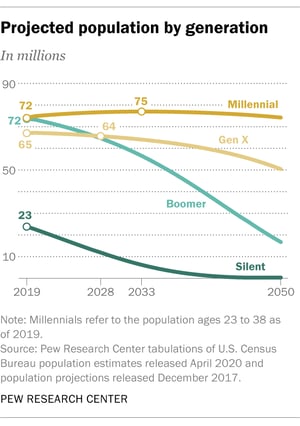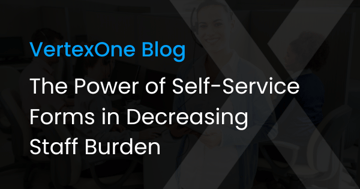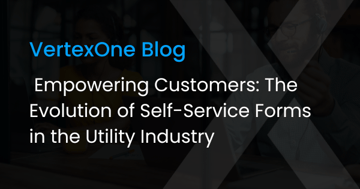With an astonishing population of over 73 million, millennials have surpassed the baby boomers and emerged as the dominant demographic group in North America. Born in the final two decades of the 20th Century, they have now embraced adulthood and are immersing themselves in the world of homeownership and starting their own families. This generation is reshaping the cultural landscape with their unique blend of traditional values and digital prowess. 
However, what truly sets this generation apart is their deep immersion in the information era. Millennials grew up with computers and instant communication at their fingertips. They effortlessly navigate the Internet of Things, a hyperconnected environment that allows them to engage in conversations and transactions anytime and anywhere, using their preferred device. Having the power to manage every aspect of their lives online, it's only natural for them to expect the same level of convenience from their utility providers.
This newfound convenience has led to a redefinition of consumer expectations, not just for millennials, but also for their parents and grandparents. Many of them have bid farewell to traditional checkbooks and embraced electronic payment methods for their utility bills. However, online bill payment is just the tip of the iceberg when it comes to meeting these evolving customer expectations. As we enter a new decade, it's crucial for utility providers to adopt a fresh perspective on the customer experience, one that places customer self-service at the forefront of their customer information systems.
Taking Careful Aim: How to Notch Wins Even When the Goalposts are on the Move
When information systems evolve, consumer expectations evolve alongside them. Consequently, utility customers, like any other customer today, now expect to access billing statements and account information online. They are also willing to forego human interaction and address their customer service needs by making use of both interactive telephone response systems and virtual assistants.
In other words, nearly all utility service capabilities are now self-service capabilities—or at least they should be. Beyond environmentally friendly paperless options for paying their monthly bills, customers want to be able to monitor their usage and view their account status in real-time. They also expect payments to post immediately and send them an email receipt. They want to be empowered to add to or change their services whenever they like. And they want to do all this from desktop computers, smartphones, tablets, and—most recently—voice-controlled home assistants.
Meeting such expectations—or exceeding them—is an activity for which utility providers must budget. However, implementing a modern customer self-service (CSS) platform will do more than provide your customers with the level of service they demand. It will also help your business realize cost-savings, diversify its revenue streams, and optimize its day-to-day operations.
When choosing a CSS platform, it is essential to select one that meets the self-service needs of today's utility customers. However, it is crucial to avoid a user interface (UI) that creates friction and hampers functionality, as this can hinder adoption of the platform. To maximize the benefits, it is advisable to invest in a visually appealing, well-organized, and enjoyable user experience (UX) within the CSS platform.
Selecting the right CSS platform also necessitates a thorough understanding of your customers' journey. What are their priorities? What are their pain points and goals? Which operations can be effectively automated, allowing users to complete tasks without the need for human intervention, while still maintaining crucial aspects of the customer experience?
By implementing a CSS platform that enables customers to conveniently pay bills, enroll in loyalty programs, update their addresses, and access historical billing information, utility providers can significantly reduce labor costs at call centers, walk-in facilities, and other customer touchpoints. Even with a conservative estimate of 50,000 self-service operations per year, with an average cost per call of $6, the savings can amount to $300,000.
Furthermore, by embracing paperless billing, utility providers can not only promote ease-of-use but also achieve additional cost savings by eliminating expenses associated with legacy systems such as printing and postage.
In order to effectively engage with customers and drive revenue in the digital age, utility providers must adopt a new approach. Traditional methods like mass mailings and generic email blasts are no longer effective. Today's consumers expect personalized offers that cater to their individual needs and interests. This is where a modern Customer Self-Service (CSS) platform becomes essential.
Using data to Personalize and Improve ROI
By harnessing the power of data collected through customer information systems, utility providers can target marketing campaigns to specific individuals, offering them the most relevant and useful promotions. This personalized approach not only increases conversion rates but also delivers a higher return on investment for marketing efforts.
Gone are the days of broadcasting identical messages to a diverse audience. With a robust CSS platform, utility providers can create personalized connections that truly engage customers and drive new revenue. It is time to embrace the digital revolution and transform how customer acquisition and retention costs are calculated. The transformative potential of customer self-service technology must be harnessed.
Failing to understand and meet customers' expectations will only give competitors the opportunity to take advantage. Today's utility customers not only want to be informed about new products, special offers, and money-saving bundles, but they also rely on their providers to promptly alert them of any abnormalities in their usage that could indicate urgent issues like a gas leak or electrical failure.
Utility customers now demand access to their accounts 24/7, 365 days a year, through their preferred devices. With the help of advanced CSS systems, providers can proactively interpret customer and usage data to effectively communicate with their customers, building trust and loyalty.
In deregulated markets, this personalized customer experience can be a powerful differentiator, enabling providers to expand their customer base and gain a competitive advantage. In regulated markets, implementing a modern CSS not only satisfies regulators that costs are reasonable but also brings cost efficiencies to the business.
To meet evolving expectations and stay ahead in the utility industry, it is essential to harness the transformative potential of customer self-service technology.
Harnessing the Transformative Potential of Automation: Your Organization’s Path to Leaner Operations and Empowered Employees
In today's advanced technological landscape, the automation of repetitive and predictable tasks has become a game-changer across industries. This transformative trend is poised to grow exponentially in the coming decades. According to Forrester, the revenue of robotic process automation (RPA) vendors is projected to reach nearly $8 billion in 2020, with the global market for their services expected to surpass $12 billion by 2023. Leading the charge, innovative utility providers have embraced robust CSS platforms that streamline customer service operations.
By automating mundane and often monotonous clerical tasks, utility providers can tap into their employees' extensive knowledge, skills, and creative problem-solving abilities. This optimized utilization of human resources not only boosts employee satisfaction but also fuels continuous improvement and growth throughout the organization.
One department that can immediately benefit from the reallocation of human resources is customer service. With routine requests efficiently handled by chatbots or self-service applications, customer service representatives can devote their time and expertise to resolving complex issues that warrant escalation.
Simultaneously, other team members can be empowered to perform predictive analyses based on past customer service interactions and outcomes. Such endeavors further enhance the unique and differentiating qualities of the customer service experience that your brand delivers.
Harnessing the Transformative Potential of Customer Self-Service Technology
In this modern era, it's not only millennials who have elevated expectations when it comes to utility providers' customer self-service capabilities. The expectations of all utility customers have evolved. Whether they belong to the millennial generation, baby boomers, digital natives, or are just starting to embrace smart technology, today's customer base demands transparency, socially responsible business practices, instant access, and personalized experiences.
Now is the perfect time to reevaluate the customer experiences your utility offers, but it's important to do so from a comprehensive perspective. Consider how enhancing your CSS capabilities can benefit your organization now and in the future. By achieving measurable cost-savings and creating new revenue streams through upgraded information systems, you will strengthen your utility's position in the face of rapid technological advancements and energy market volatility.




